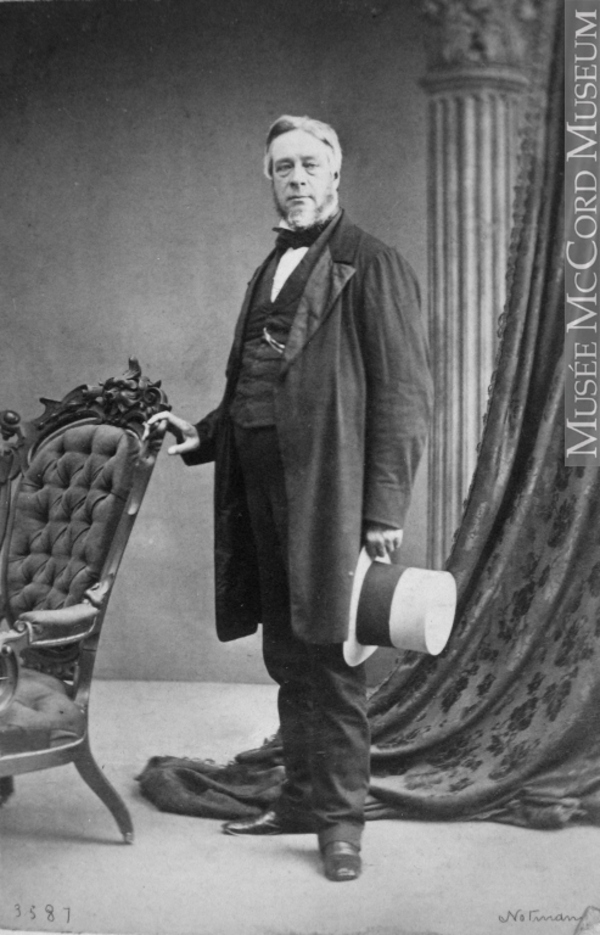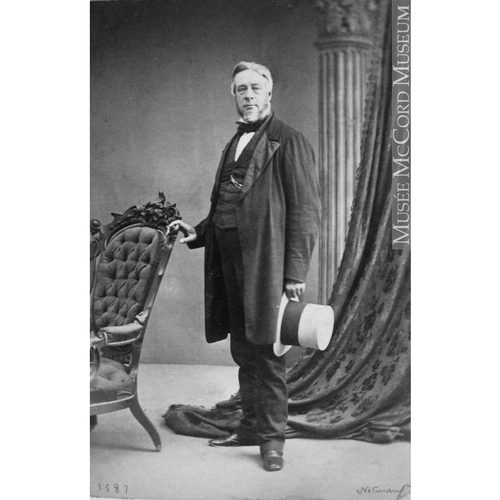As part of the funding agreement between the Dictionary of Canadian Biography and the Canadian Museum of History, we invite readers to take part in a short survey.

Source: Link
TORRANCE, DAVID, merchant, shipper, and president of the Bank of Montreal; b. 1805, New York, N.Y., son of James and Elizabeth Kissock Torrance; d. 29 Jan. 1876 at Montreal, Que.
The Torrances were a Scottish Lowland family who came from Larkhall in Lanark. Five brothers, sons of Thomas Torrance (1735–1805), emigrated to Canada via New York shortly after the turn of the 19th century. Of these, Thomas (1776–1826) and John* (1786–1870) settled at Montreal, where they established wholesale and retail groceries, trading largely in wines and liquor; James went to Kingston, Upper Canada, where he acted as the agent for the forwarding business of the family and carried on commercial operations of his own. The first two, at least, became very prosperous as a result of the War of 1812.
David Torrance, the son of James, went to Montreal about 1821 to work in his uncle John’s St Paul Street business, John Torrance and Company. Among the firm’s clerks were Henry Wilkes*, the future Congregationalist minister, and John Young, with whom David was to operate a Quebec City partnership, known as Torrance and Young, for some five years after 1835. On 9 Jan. 1832, David married his cousin Jane Torrance (1812–75),the eldest daughter of his uncle John, and in 1833 he became a partner in the business. In the years following he assumed an important role in Montreal commerce and with his uncle’s retirement in 1853 the firm became David Torrance and Company. His partners were Thomas Cramp* and later also his own son, John Torrance Jr (1835–1908). With Cramp and another son, George William Torrance (c. 1849-1911), David also formed a second partnership in Toronto entitled Cramp, Torrances and Company. The John Torrance businesses dealt in all forms of general merchandizing, but specialized in teas; from the late 1820s the Torrances challenged the monopoly of Forsyth, Richardson and Company in tea importation. They were the first Canadian firm to deal directly with China and India, where their name was well known for over 30 years; in 1853 they began holding annual sales of teas imported directly from China. At the time of David’s death Bradstreet estimated the value of David Torrance and Company in Montreal at $400,000-$500,000.
John Torrance and Company were also interested in shipping and their Montreal Tow Boat Company was to be the first to rival the Molsons in river shipping [see William Molson]. In 1825 the company gained control of the powerful steam tug Hercules, and over the next few years had steamers for both passengers and freight plying the Montreal-Quebec route, including the St George, British America, and the 240-foot Canada, the last being the largest and fastest boat in British North America. By 1831 they were also operating the Voyageur and the Edmund Henry between Montreal and Laprairie, and in 1833 they added the Britannia. Competition with the Molsons on the St Lawrence was at first fierce, but in 1833 both parties “agreed to unite in forming a daily line between Quebec and Montreal for the convenience of the public.” At the same time passenger and barge traffic were separated. The Montreal and Quebec Steamboat Company, as the Torrance firm became known, soon had agents at Quebec, Trois-Rivières, Sorel, and Saint-François (Yamaska County) and new boats were added during the 1840s. In late 1853 the Montreal, which they owned with the Molsons and others, was lost off Cape Batiscan, in a snowstorm. The 1850s saw another period of competition, for by 1852 the Tate brothers had established a rival line and in 1856 the Richelieu Company (La Compagnie du Richelieu) [see Jacques-Félix Sincennes] extended its operations to the Montreal-Quebec route. This rivalry resulted in both reduced fares and competitive races until 1858, when an amalgamation was arranged under which the Torrance Company was merged in the Richelieu Line, of which David Torrance became a director.
In 1870 Torrance branched into a different type of shipping, when he became involved with the new Mississippi and Dominion Steamship Company Limited, which was chartered to develop trade from Liverpool to New Orleans and Montreal. The American connection was soon discontinued and the name changed to the Dominion Line; the Torrance family retained its agency long after David’s death.
David Torrance’s other main financial interest was the Bank of Montreal. His uncle, Thomas Torrance, had been one of the original shareholders in 1817 and a year later had been elected to the Board of Directors, an office he held until his death in 1826. Thomas’ brother John succeeded him and remained a director until 1857; meanwhile, in 1853, David had been elected to the board and by the time Edwin H. King* resigned from the presidency in 1873, he was second in seniority. When Senator Thomas Ryan, the senior director, refused the office of president, the board, of which David’s brother-in-law, Sir Alexander Tilloch Galt*, had just become a member, elected Torrance president.
Torrance’s presidency of the bank was a short one, for he died in early 1876 and was ill through most of 1875. It was also marked by the major depression which began in 1873, shortly after he was elected president. Nevertheless, profits remained steady, dividends were held at 14 per cent, a loan of $1,250,000 was made to the Grand Trunk Railway in 1873, and in 1874 the bank entered the field of investment banking by jointly underwriting an issue of Quebec provincial bonds with the London firm of Morton, Rose and Company, one of whose principals was its London agent, Sir John Rose*. Torrance’s term, however, is easily overlooked, coming as it did between the brilliant presidencies of King and his own vice-president and successor, George Stephen*, later Baron Mount Stephen.
David Torrance was noted for the regularity of his attention to his work; the Montreal Daily Witness summed this up well in his obituary when it stated “he was a diligent merchant, and did not meddle much in public affairs, though he was a consistent Liberal in politics throughout.” His only real political activity was in connection with the annexation movement in 1849, when he was treasurer of the Montreal Annexation Association and fifth of the 325 initial signatories of the Annexation Manifesto.
The Torrance family was originally Presbyterian, but became Methodist and was active in the affairs of the St James Street Methodist Church; David contributed £100 to the building fund for the second church in 1845. He became a charter member of the St James Club in 1857. Torrance was also a member of the Montreal Board of Trade, was on its council, and was a member of its committee which was active in obtaining the second act of incorporation for Montreal in 1840. In 1845 he was commissioned a captain in the 8th Battalion, Montreal militia, and in 1847 recommissioned in the 6th Battalion, but was dismissed in 1850 for his part in the annexation movement. In addition he was prominently associated in many benevolent and philanthropic undertakings. Examples are his directorship in the High School of Montreal, which he helped establish in 1843, and his many charitable donations to the Montreal General Hospital, of which he was a governor from 1869 to 1876.
He was survived by five children and one son and four daughters predeceased him. Besides the sons who succeeded him in the business, another son, Edward Fraser Torrance, became minister of St Paul’s Presbyterian Church, Peterborough, 1876–1909. David Torrance was an able businessman and a conscientious worker, who “in the days of his prosperity was as regular in attendance at the counting house as when he first started in business.” His activities in business, in religion, and with most of his interests, however, seem to be very much a continuation of those of his uncle cum father-in-law John Torrance, who, with his brother Thomas, was the real innovator and founder of the family fortunes.
AJM, will of David Torrance, 7 April 1875. PAC, RG 1, L3L, 194, pp.92426–52; RG 9, I, A3, 12; A5, 16, pp.437–38; C4, 1, pp.145, 150; C4, 4, p.266. Bank of Montreal Archives (Montreal), Minute book of the board of directors, 1873–76. Molson Archives (Molson’s Brewery, Montreal). “The annexation movement, 1849–50,” ed. A. G. Penny, CHR, V (1924), 237. Bradstreet’s reports of the dominion of Canada, February 1, 1876 (New York, 1876), 642. Montreal Daily Witness, 20 Jan. 1870, 31 Jan. 1876. Montreal Herald, 15 Oct. 1849, 21 Jan. 1870. The Canadian men and women of the time: a handbook of Canadian biography, ed. H. J. Morgan (1st ed., Toronto, 1898). Notman and Taylor, Portraits of British Americans, II, 228. C. D. Allin and G. M. Jones, Annexation, preferential trade and reciprocity; an outline of the Canadian annexation movement of 1849–1850, with special reference to the questions of preferential trade and reciprocity (Toronto and London, 1912), 114. Atherton, Montreal, II, 168, 531, 574, 577. Campbell, Hist. of Scotch Presbyterian Church, 313–16. Canada, an encyclopedia, V, 443. The centenary of the Bank of Montreal, 1817–1917 (Montreal, 1917), 50–51, 80. E. A. Collard, The Saint James’s Club; the story of the beginnings of the Saint James’s Club (Montreal, 1957), 12–13. James Croil, Steam navigation in Canada and its relation to the commerce of Canada and the United States (Toronto, 1898), 221, 308–10, 313–15. Merrill Denison, The barley and the stream; the Molson story . . . (Toronto, 1955), 90, 92, 95, 148, 152, 159–60; Canada’s first bank, I, 162, 299; II. G. E. Jacques, Chronicles of the St. James St. Methodist Church, Montreal, from the first rise of Methodism in Montreal to the laying of the corner-stone of the new church on St. Catherine Street (Toronto, 1888), 68, 84, 90. L. C. Tombs, National problems of Canada; the port of Montreal (McGill University Economic Studies, 6, Toronto, 1926), 36, 38.
Cite This Article
Frederick H. Armstrong, “TORRANCE, DAVID,” in Dictionary of Canadian Biography, vol. 10, University of Toronto/Université Laval, 2003–, accessed March 30, 2025, https://www.biographi.ca/en/bio/torrance_david_10E.html.
The citation above shows the format for footnotes and endnotes according to the Chicago manual of style (16th edition). Information to be used in other citation formats:
| Permalink: | https://www.biographi.ca/en/bio/torrance_david_10E.html |
| Author of Article: | Frederick H. Armstrong |
| Title of Article: | TORRANCE, DAVID |
| Publication Name: | Dictionary of Canadian Biography, vol. 10 |
| Publisher: | University of Toronto/Université Laval |
| Year of revision: | 1972 |
| Access Date: | March 30, 2025 |



